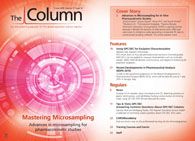Parabens Detected in Plastic Teething Toys
Parabens are commonly used in cosmetics and personal care products to protect against microbial growth, but a new study suggests that manufacturers may also be using parabens in plastic teething products designed for infants. Scientists applied an effect-directed approach (to determine endocrine disrupting ability) to analyze teething products prior to chemical analysis using gas chromatography coupled to mass spectrometry (GC–MS). Of 10 products were tested, two were found to contain endocrine disrupting chemicals (EDCs).
Photo Credit: RUTH JENKINSON/SPL/Getty Images

Parabens are commonly used in cosmetics and personal care products to protect against microbial growth, but a new study published in the Journal of Applied Toxicology suggests that manufacturers may also be using parabens in plastic teething products designed for infants.1 Scientists applied an effect-directed approach (to determine endocrine disrupting ability) to analyze teething products prior to chemical analysis using gas chromatography coupled to mass spectrometry (GC–MS). Of 10 products were tested, two were found to contain endocrine disrupting chemicals (EDCs).
EDCs are natural or synthetic compounds that disrupt the normal functioning of the human endocrine system, often imitating natural hormones, and are recognized as a contributing factor to a range of diseases. In light of this, the use of phthalates in toys is restricted in the European Union to reduce childhood exposure. However, there is a huge variety of possible EDCs used in plastics, meaning that exposure is likely to be underestimated because analysis focuses on common culprits such as Bisphenol A and phthalates. Corresponding author Martin Wagner from Goethe University Frankfurt am Main, Germany, told The Column: “Our research is about the EDCs we do not know yet: Instead of analyzing well known compounds, we use in vitro bioassays to screen all types of samples for hormonal activity and try to identify the causative chemicals using non-target chemical analysis afterwards (effect-directed analysis).” He added: “In that sense, our research demonstrates that there are far more EDCs out there (which we currently overlook) and that they come from unexpected sources (who would have suspected a plastic to contain parabens).”
Samples were taken from 10 plastic and one natural rubber teething soothers purchased in Germany in 2012. Methanol extracts and water eluates from the samples were screened using a Yeast Estrogen Screen (YES) and a Yeast Antiandrogen Screen (YAAS). One sample was shown to possess both estrogenic and antiandrogenic activity, and another was found to be antiandrogenic. GC–MS analysis showed the presence of ethyl-, methyl-, and propylparaben in one product. Wagner told The Column: “In [the] case of one product we found three different parabens. These are well-known EDCs, which are normally used as preservatives in cosmetics.” He added: “In [the] case of the second product, we demonstrated that this teether leached six different EDCs, all of which remain so far unidentified. In a broader sense, our study demonstrates that babies will be exposed to EDCs when chewing on plastic teethers. Because they are especially susceptible, we should aim at minimizing their exposure to EDCs.” - B.D.
Reference
1. E. Berger et al., Journal of Applied Toxicology DOI 10.1002/jat.3159 (2015).
This story was featured in LCGC's digital magazine, The Column. Click here to view the full issue>>

New TRC Facility Accelerates Innovation and Delivery
April 25th 2025We’ve expanded our capabilities with a state-of-the-art, 200,000 sq ft TRC facility in Toronto, completed in 2024 and staffed by over 100 PhD- and MSc-level scientists. This investment enables the development of more innovative compounds, a broader catalogue and custom offering, and streamlined operations for faster delivery. • Our extensive range of over 100,000 high-quality research chemicals—including APIs, metabolites, and impurities in both native and stable isotope-labelled forms—provides essential tools for uncovering molecular disease mechanisms and exploring new opportunities for therapeutic intervention.
New Guide: Characterising Impurity Standards – What Defines “Good Enough?”
April 25th 2025Impurity reference standards (IRSs) are essential for accurately identifying and quantifying impurities in pharmaceutical development and manufacturing. Yet, with limited regulatory guidance on how much characterisation is truly required for different applications, selecting the right standard can be challenging. To help, LGC has developed a new interactive multimedia guide, packed with expert insights to support your decision-making and give you greater confidence when choosing the right IRS for your specific needs.

.png&w=3840&q=75)

.png&w=3840&q=75)



.png&w=3840&q=75)



.png&w=3840&q=75)








